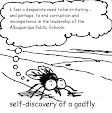By way of illustration, there was a semester during my tenure
as a middle school teacher, when I was assigned "lunch duty".
It was my task to keep students from cutting into the line for
the snack bar, including keeping them from passing their order
and their money through a chain link fence.
I couldn't begin to tell you how many times I said, please
get away from the fence.
Then one day, I painted a thin yellow line on the asphalt about
ten feet from the fence. And that was the end of the problem.
Note that; even the width of the line plays. Had I made the line
wider, I would have had to argue with students over whether
a foot on the line, is a foot over the line. A gray line is a wide
line.
In the context of encouraging children to grow into adults,
the difference being self discipline, lines are an absolute necessity.
The controverting opinion is that there are no lines, everything
is relative, and the difference between right and wrong, good
and evil, black and white, is a gray area.
There really aren't many areas that are really gray. The gray
most people perceive is actually an effect created by moving
a clear line around so quickly that the line appears gray.
The existence of gray, is always suggested by the person who
has just stepped over the line, and who does not want to
experience the consequences of having stepped over the line.
Gray areas are always created by the perpetrator, never by the
victim.
As problems become more complex, sophisticated minds are
able to perceive and explore "gray" areas. The younger the
mind, the less able they are to understand the subtle nuances
that gray decision making.
Young minds need clear, narrow lines.
"Gray" behavior cannot be role modeled because it cannot
be quantified or qualified. If it could, it wouldn't be gray.
Role models cannot move in the gray areas. Young minds
don't perceive the sophisticated thinking of graying,
they only see a line being crossed, or a line being ignored.
The logical extension of graying any line, is to gray all lines.
The Pillars of Character Counts! describe a clear line
between men and women of character, and everyone else.
Character Counts! is a dismal failure in the APS, because
the leadership of the APS has no respect for lines. There is
no administrator or board member who will ever be held
accountable for crossing a line, because when they do cross
a line, APS Modrall will litigate a different line, where ever
they want.
If we want children to understand the differences between
character and the lack of character, role models must be
willing to forgo whatever slight advantage they may gain
by pushing the line, in order to preserve the line.
"Enforcers", those whose responsibilities includes providing
consequences for stepping over the line, are as likely as the
"perpetrator", to want to gray the line, but for a different reason.
Perpetrators want to gray lines to escape consequences;
enforcers gray the line to avoid having to provide consequences.
There is a considerable downside to providing consequences;
especially to providing consequences to children.
The worst possible thing you can do, is to draw lines and then
fail to provide consequences for having crossed them. All you
do is train kids to ignore lines.
Take for example the issue of "sagging". link
It was for a time, against school board policy to sag.
The saggers pushed back, and the school board caved in.
It is no longer against school board policy to sag.
The lesson the saggers learned was; the line can be ignored
without consequence. According to a psychological tenet
called "generalization", saggers learned that all lines can
be ignored without consequence.
One is far better off, to simply ignore certain behaviors, than
to create rules against the behavior which will then, not be
enforced.
APS schools are out of control.
In any school where prohibited behavior is permitted,
students are in charge. Adults may argue that they are in
charge, but the simple fact is; the person who's will is being
done, is in charge.
No factor contributes to the failure of schools, to a larger
extent than, schools out of adult control.
They will not be under adult control, until adults draw some
appropriate lines, and then enforce them absolutely and
even upon themselves.
If we want children to embrace honest accountability to
meaningful standards of conduct;
someone has to show them what it looks like.
Monday, May 11, 2009
Sometimes, you have to draw the line.
Posted by
ched macquigg
at
7:07 AM
![]()
Subscribe to:
Post Comments (Atom)

1 comment:
good example, well-stated, and very true.
Post a Comment